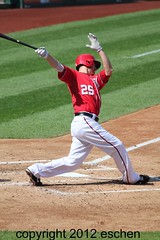
Adam LaRoche
courtesy of ameschen
Many Nationals fans would label Adam LaRoche as the team’s 2012 MVP, and many would label Danny Espinosa as the Nat on the hottest of hot seats. You see in 2012 Adam LaRoche hit .271/.343/.510 with 33 homers and 100 RBI while Danny Espinosa hit .247/.315/.402 and led the NL in strikeouts. That makes Adam LaRoche a highly valuable batter and Danny Espinosa below average batter. In 2012 the MLB average hitter batted .255/.319/.405. Espinosa is below that slash line in every category while LaRoche is over it and in some cases significantly over it. Now that I have made the brief case as to why LaRoche is better than Espinosa I am going to tell you it isn’t true. By the advanced metric fWAR both LaRoche and Espinosa were 3.8 win players. Meaning they were equally valuable to the Nats.
When I showed you that LaRoche was a well above league average hitter and Espinosa was a below league average hitter I left off a lot of information. WAR takes everything into account (Sam Miller of ESPN and Baseball Prospectus had a great article on WAR come out yesterday and all baseball fans should give it a read). One of the things that WAR takes into account is positional difference. Basically it is the old baseball adage of defense up the middle, power at the corners. Comparing the batting ability of a first baseman to a second baseman head to head is unfair and misses a large portion of the important of the middle infield position.
In the 1980’s Bill James introduced us to the Defensive Spectrum. The basic point is that the hardest defensive positions to find players for are the up the middle positions in the order; catcher, short stop, second baseman, and center fielder. The basic point is that finding a good second baseman isn’t easy, and because it isn’t easy teams will tolerate less offensive from the position in order to achieve better defense. Let’s take Danny Espinosa and now compare him to the average MLB second baseman. In 2012 Espinosa had a batting line of .247/.315/.402 and the average second baseman .257/.318/.383. Danny Espinosa is a few points lower on batting average but that doesn’t matter so much as his OBP is close enough to league average to be called league average, and most importantly Danny Espinosa has .019 more points of slugging than the average second baseman. If we go back to WAR for a second Danny Espinosa is deriving most of his value from his defense and power.
In total OPS Danny Espinosa has a .015 OPS advantage over an average MLB second baseman. Now let’s look at LaRoche. In 2012 LaRoche hit .271/.343/.510 and a MLB average first baseman .262/.336/.442. LaRoche is still above average in all of those categories but not by nearly as much as he was when all positions were lumped together. In total LaRoche has a .075 OPS advantage 0r just .060 advantage over Espinosa when positional difference is factored in.
It is important to factor in a players defensive position when talking about them as an offensive player. There are other issues the Nats are dealing with when it comes to offense and a player’s defensive position. The move of Harper from center to left chief among them. I wrote about this elsewhere the other day so as not to simply regurgitate that I will provide a link. The main point of that is while positional difference is important it also shifts over time. Back to Espinosa vs. LaRoche for a second. In the current baseball environment the talent of first basemen in despressed. Just five seasons ago in 2007 the average first baseman hit .276/.357/.463. In that environment LaRoche wasn’t nearly as valuable as LaRoche is now. Lots of Nats fans are worried about the regression of Adam LaRoche but in reality he only had an OPS .030 points higher than his career average, but environment and era is a tale for another time.
How useful is it to compare across positions? My gut tells me that on paper a group of above average “up the middle” guys teamed with below average “corner” guys would significantly underperform their cumulative fWAR. True or not?
I am not sure if they can outperform their fWAR. A team of replacement players would win between 45-50 games so add cumulative fWAR to that for a range. A below average player would be a 0.1-1.99 fWAR player regardless of position. Having below average hitters at the corners is more damaging to overall offense than below average offense up the middle players as the value for up the middle positions is derived primarily from defense. If you look at the Phillies in 2011 when they were the best team in baseball their only above average corner players were either part time or deadline acquisitions.